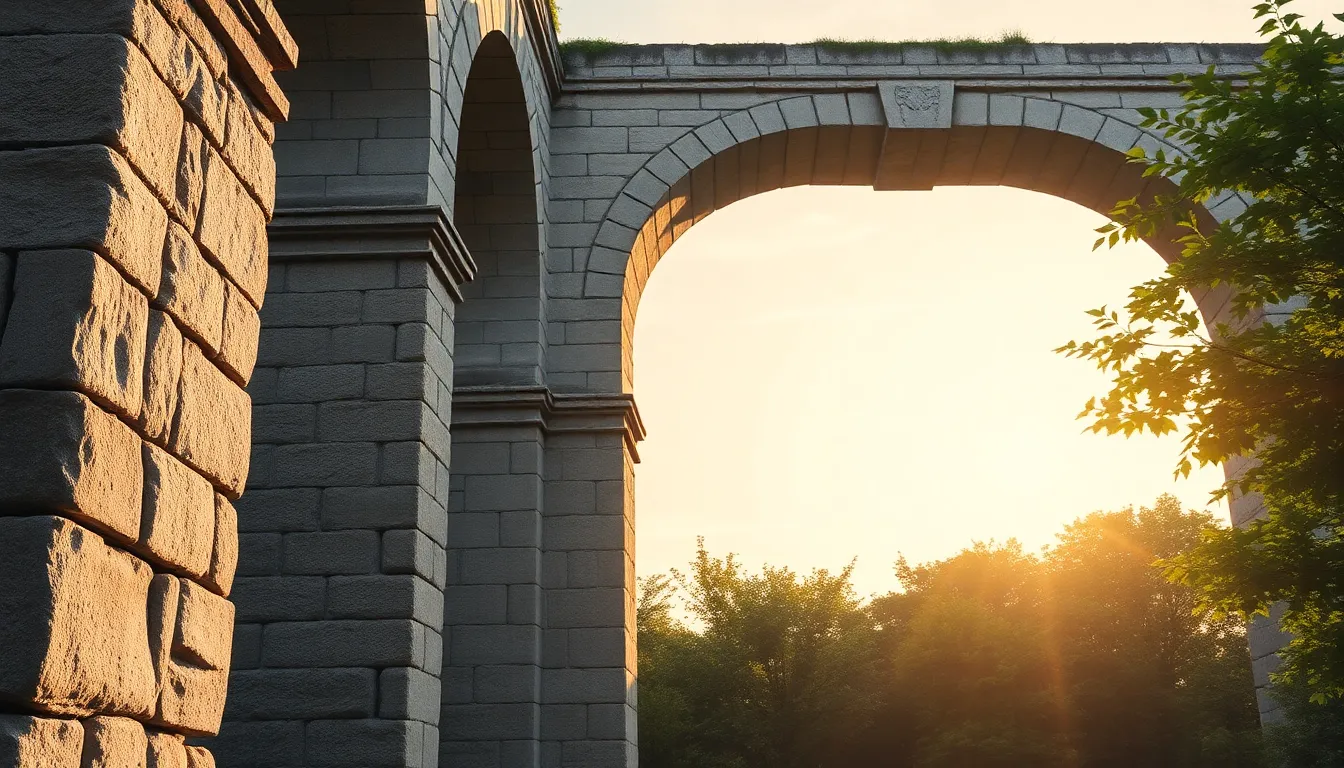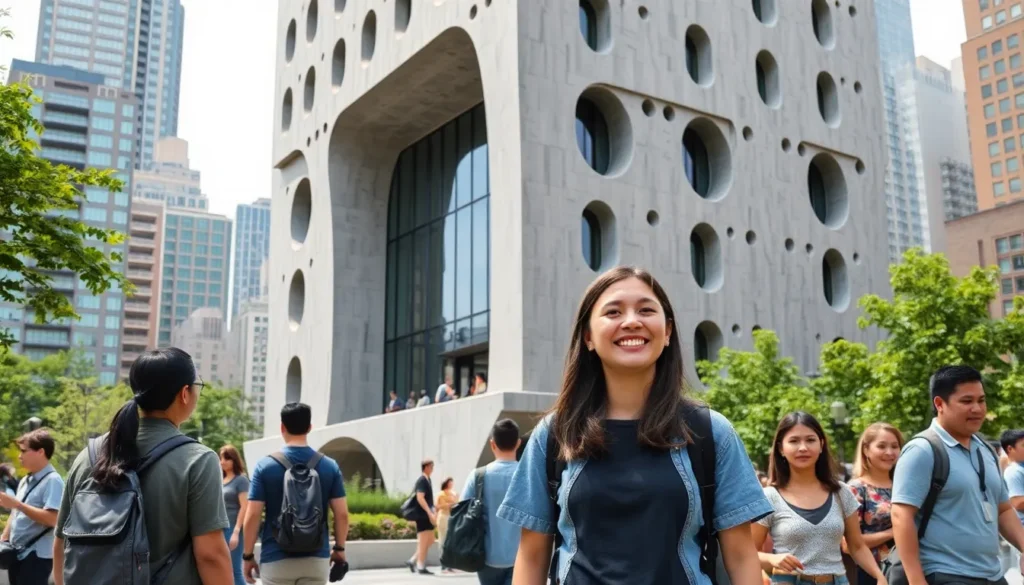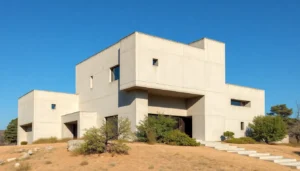Concrete architecture isn’t just about gray blocks and straight lines; it’s a bold statement that can transform urban landscapes into stunning works of art. Imagine walking through a city where each building tells a story, showcasing creativity and innovation. This sturdy material, often underestimated, has the power to evoke emotion and inspire awe, turning ordinary spaces into extraordinary experiences.
Overview of Concrete Architecture
Concrete architecture embodies a versatile and innovative design approach. It transcends traditional perceptions, revealing complex forms and expressive structures. This material supports various architectural styles, enabling both minimalist and intricate designs. Architects leverage concrete’s strength to create tall skyscrapers, bridges, and public spaces that enhance urban environments.
Unique characteristics define concrete as a building material. Its durability provides longevity, reducing maintenance costs. With advancements in technology, techniques like 3D printing and prefabrication facilitate new possibilities in concrete construction. These innovations allow for intricate detailing and customization, offering architects greater creative freedom.
Sustainability factors into modern concrete architecture. Innovations in eco-friendly concrete mixtures, which incorporate recycled materials, minimize environmental impact. The use of insulating concrete forms ensures energy efficiency, promoting a lower carbon footprint in structures. Designers increasingly focus on creating spaces that harmonize with nature while reducing energy consumption.
Additionally, concrete architecture communicates a sense of permanence and solidity. Structures built with concrete often leave a lasting impression on cityscapes. Famous examples, such as the Sydney Opera House and the Habitat 67, showcase concrete’s capability to evoke emotions and inspire awe. Such landmarks act as testaments to the potential of concrete when combined with visionary design.
Ultimately, concrete architecture captures creativity and forward-thinking. Its influence can be seen in both historical and contemporary contexts. From community centers to gallery spaces, concrete continues to redefine possibilities in architecture, encouraging exploration and innovation at every turn.
Historical Background

Concrete architecture has deep roots that trace back thousands of years. Ancient civilizations utilized lime-based concrete for structures like the Pantheon in Rome, showcasing its versatility and endurance.
Early Developments
The Romans pioneered the use of concrete, allowing for innovative designs and expansive structures. They utilized volcanic ash mixed with lime and water to create a strong, durable material that could withstand the test of time. Early churches and aqueducts emerged from this expertise, demonstrating the adaptability of concrete in various constructions. Byzantine architecture later saw the evolution of concrete use, incorporating it into majestic domes and fortifications. These historical foundations paved the way for modern architectural advancements.
Modern Innovations
Recent advancements revolutionized concrete’s application in architecture. Engineers now use ultra-high-performance concrete, enabling unique shapes and fewer structural constraints. Innovations like 3D printing and prefabrication enhance the material’s versatility, allowing for stunning, intricate designs. Sustainable practices in concrete production, such as incorporating recycled materials, contribute to a lower environmental impact. Architectural wonders like the Bosco Verticale in Milan exemplify how modern concrete techniques redefine urban living, combining aesthetics with functionality. These innovations recognize concrete’s potential to create meaningful spaces while prioritizing sustainability.
Key Characteristics of Concrete Architecture
Concrete architecture stands out for its remarkable qualities that elevate both functionality and aesthetic appeal. Its unique characteristics make it a preferred choice in various architectural designs.
Strength and Durability
Strength defines concrete, making it suitable for buildings that endure harsh conditions. Durability ensures longevity, reducing the likelihood of repairs and maintenance. Structures made from concrete resist weathering, pests, and fire, which contributes to their lifespan. This material also withstands loads, allowing for taller and more intricate designs. Advanced formulations, such as high-strength concrete, further enhance performance in demanding environments. Architects often prefer concrete for its reliability, especially in urban settings where safety is paramount.
Aesthetic Versatility
Aesthetic versatility elevates concrete beyond its gray exterior. The material allows for diverse forms, textures, and finishes, enabling creative expression in architecture. Techniques like stamping and polishing create visually striking surfaces that capture attention. Colors and patterns contribute to unique design elements, making each structure distinctive. From sleek modern designs to organic shapes, concrete accommodates various architectural styles. Additionally, incorporating natural elements into concrete blends indoor and outdoor environments, enhancing appeal. This flexibility makes concrete a dynamic choice in contemporary architecture.
Notable Examples of Concrete Architecture
Concrete architecture showcases remarkable ingenuity and creativity in various forms across the globe. This section focuses on prominent structures and influential architects who have pushed the boundaries of this material.
Landmark Structures
Renowned for innovation, the Sydney Opera House in Australia features a shell-like design crafted from precast concrete. The National Gallery of Canada, architected by Moshe Safdie, showcases stunning visual and structural clarity with its striking concrete and glass combination. The Unite d’Habitation in Marseille, designed by Le Corbusier, presents a modular approach that enhances community living using raw concrete. Brasilia’s Cathedral of Brasília, created by Oscar Niemeyer, stands out with its soaring hyperboloid structure, symbolizing the importance of faith and connection. These landmark structures exemplify how concrete can transform urban landscapes and embody unique cultural values.
Influential Architects
Renowned architect Louis Kahn integrated concrete’s strength and beauty into buildings that evoke emotional responses. Tadao Ando, famed for his minimalist approach, uses concrete to create serene and contemplative spaces that merge with nature. Zaha Hadid pushed creative boundaries, designing flamboyant structures that utilize concrete’s versatility. In contrast, I.M. Pei employed concrete to achieve distinctive geometric forms and refine modernist principles. These architects significantly impacted concrete architecture, redefining design possibilities and inspiring future generations.
Environmental Impact of Concrete Architecture
Concrete architecture significantly impacts the environment, providing both opportunities and challenges. The production of cement, a key ingredient, contributes approximately 8% of global CO2 emissions. Efforts to create eco-friendly concrete mixtures and reduce energy consumption during production can minimize this footprint.
Sustainable practices in concrete architecture enhance its benefits. Incorporating recycled materials such as crushed concrete or industrial by-products lessens the demand for virgin resources. Innovative techniques like using fly ash or slag in concrete mixtures improve performance while promoting sustainability.
Energy efficiency plays a crucial role in concrete buildings. Properly designed concrete structures can enhance insulation, reducing heating and cooling demands. Consequently, these properties lead to lower energy costs and diminished greenhouse gas emissions throughout the lifespan of the building.
Moreover, advancements in construction technology provide additional environmental advantages. Concepts like 3D printing and prefabrication reduce waste by optimizing material usage and minimizing on-site construction time. These methods streamline processes while augmenting structural efficiency.
The longevity of concrete architecture contributes positively to environmental sustainability. Durable structures require less frequent replacement or repair, lowering the amounts of waste generated over time. High-performance concrete enhances this aspect, boasting extended lifespans with reduced maintenance requirements.
Concrete architecture can integrate natural elements, promoting ecological connections. Features like green roofs and permeable surfaces enhance stormwater management and biodiversity within urban environments. Urban planners increasingly recognize these benefits, advocating for designs that harmonize with nature.
Ultimately, the balance between concrete’s environmental impact and its architectural advantages continues to evolve. Ongoing research and innovation aim to unlock new possibilities in sustainable concrete practices, paving the way for a more eco-conscious future in architecture.
Future Trends in Concrete Architecture
Innovative materials and techniques are shaping the future of concrete architecture. Advances like self-healing concrete utilize embedded bacteria to repair cracks, enhancing durability and reducing maintenance. Smart concrete, which incorporates sensors, allows for real-time monitoring of structural integrity.
Sustainability trends emphasize the use of recycled materials in concrete mixtures. Eco-conscious practices lead to lower carbon footprints and align with global efforts to reduce greenhouse gas emissions. Utilizing green manufacturing techniques further supports energy efficiency in structures.
Architects are also exploring modular designs, promoting prefabrication for reduced on-site construction times. This method minimizes waste and allows for greater design flexibility. Incorporating biophilic design elements enhances the connection between buildings and their environments, improving occupant well-being.
In urban planning, the integration of concrete in mixed-use developments illustrates its versatility. Combining residential, commercial, and recreational spaces fosters vibrant community interactions, transforming urban landscapes. Notable projects like The Line in Saudi Arabia showcase the potential of concrete architecture in creating sustainable living spaces.
The rise of digital fabrication, including 3D printing, continues to revolutionize concrete applications. This technology enables intricate designs and optimized material usage, pushing the limits of traditional construction methods. Experimenting with form and function leads to striking designs that capture public imagination.
Emerging trends also prioritize climate resilience in concrete architecture. Structures designed to withstand extreme weather conditions reflect a growing recognition of environmental challenges. Innovations in thermal performance contribute to energy-efficient buildings, reinforcing the commitment to sustainability.
Concrete architecture faces a future rich with possibilities. As architects and engineers push boundaries with creativity, technology, and sustainability, the potential for transformative design continues to expand.
Concrete architecture stands as a testament to human ingenuity and adaptability. Its ability to transform urban environments while addressing sustainability challenges is remarkable. As architects continue to explore innovative techniques and materials, the potential for concrete to create stunning, functional spaces only grows.
This material’s versatility allows for a blend of aesthetic appeal and structural integrity, ensuring that it remains relevant in modern design. With a focus on eco-friendly practices and advanced technologies, concrete architecture is poised to lead the way toward a more sustainable future. The journey of concrete is far from over, and its evolution promises to inspire awe for generations to come.





